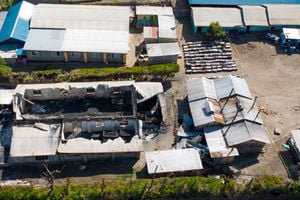Why experts are against mass planting of mangroves

Volunteers replanting mangroves in Mkupe, Mombasa County.
What you need to know:
- Planting certain mangroves species in the wrong areas is harming local ecosystems.
In recent years, Kenya has seen a surge of awareness on conservation of marine ecosystems, particularly mangrove forests, which play a crucial role in in preserving a healthy and sustainable environment.
This growing awareness has spurred increased involvement of experts, companies and local communities, who have planted thousands of seedlings to restore mangrove forests in coastal region - Kwale, Lamu, Tana River, Kilifi and Mombasa counties.
Kenya’s mangrove forests cover 61,271 hectares. They play a significant role in climate change mitigation by storing huge volumes of carbon that would otherwise evaporate and heat up the planet, among other benefits.
However, scientists and experts have raised concerns about the continuous restoration efforts that do not adhere to established guidelines, saying they are undermining the success and positive impact of the mangroves.
The experts say planting random species of trees has resulted in reduced environmental benefits since a big percentage of the mangroves fail to survive.
Wetlands International East Africa Director Julie Mulonga emphasised the need for Kenya to reassess its approaches in mangrove restoration.
She also cautioned against indiscriminate mass planting, revealing that the survival rate for such efforts is only 30 to 32 per cent.
“We have realised that mass planting of mangroves does not help because most of the trees eventually die. For example, if you plant 10,000 mangroves, the survival rate is 30 to 32 per cent," she said.
Ms Mulonga said there should be a shift towards natural restoration, which may take time but offers higher survival rates.
The Kenya Marine and Fisheries Research Institute (KMFRI) chief research scientist, Dr James Kairo, called for the use of effective mangrove restoration approaches that are science-based.
According to Dr Kairo, restoration of mangroves can only be done through a community based approach, where locals participate in the planting of seedlings. He added that similar species of mangroves should be planted in the same area. He noted that mixed species of mangroves cannot be planted in the same area since planting different species in one area may disrupt their growth.
He added that those planting the trees should ensure that sites are protected from human activities as well as livestock, and that proper monitoring is done for not less than five years.
He was speaking in Kwale County during the national mangrove dialogue, which was held ahead of the International Day of Conservation of Mangroves in Tsunza Village.
He said the challenge of planting the wrong species in the wrong places and planting in sites which mangroves cannot tolerate led to the preparation of the National Mangrove Ecosystem Restoration guidelines, a framework that will boost conservation of the trees by improving their survival rate.
The Kenya Forest Service Chairman Titus Korir said the guidelines are important since mangroves are a critical ecosystem whose benefits range from bolstering well-being, food security and protection of coastal communities. They also support rich biodiversity and provide essential nursery habitats for fish.
“These guidelines provide a standardised approach to mangrove restoration, ensuring that all conservation stakeholders are aligned to their efforts of protecting the environment. The framework will also address various environmental elements, challenges and how they can be effectively solved at both community and institutional level,” he said.
He said despite efforts to conserve the trees, mangroves are still facing challenges such as encroachment, marine pollution and unsustainable land practices. “The challenges will be addressed and eliminated through the policies being created.”
According to Forestry Principal Secretary Gitonga Mugambi, huge acres of mangrove areas in the Coast region are still in dire need of rehabilitation; and hence the need for the guidelines.
For instance, in Kwale County, at least 45 per cent of the ecosystem requires rehabilitation due to degradation. “The mangrove restoration guidelines will provide information resources essential for the conservation of the mangrove ecosystem in the country,” he said.
Over the years, the improved policies have led to conservation of the critical ecosystem that plays a key role in mitigating harsh climate effects. A section of coastal communities are also engaging in restoration and conservation projects, earning millions of shillings from carbon credits paid by international companies.
.





